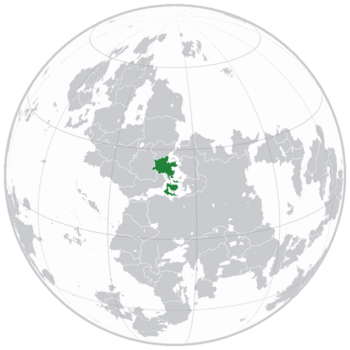Zona Umida
Federal Republic of Zona Umida
| |
|---|---|
|
Flag | |
| Motto: With pen and sword. | |
| Anthem: "My land!" | |
 The location of Zona Umida on the globe. | |
| Capital | Sediya |
| Largest | Anapa |
| Official languages |
|
| Ethnic groups | Riamese
Gallese Namese |
| Religion | Riamese Orthodoxy |
| Demonym(s) |
|
| Government | Federal presidential republic |
• President | Sebastian Michelle |
| Legislature | Parliament |
| Senate | |
| Establishment | |
• Formation of the Gallese Kingdom | 1149 |
• Conquered by the Riamese | Early 15th century |
• Incorporated into the Riamese crown | 15th century |
• Guaranteed independence by Riamo | 1880 |
| Area | |
• | 522,867.60 km2 (201,880.31 sq mi) |
| Population | |
• 2020 estimate | 28,000,000 |
• 2018 census | 27,968,000 |
| GDP (PPP) | 2018 estimate |
• Total | 219.8 billion |
• Per capita | 18,300 |
| Gini (2018) | 45.48 medium |
| Currency | Umidan hull (UH) |
| Time zone | UTC+5 (UTC) |
| Date format | mm/dd/yyyy |
| Driving side | right |
| Calling code | +299 |
| Internet TLD | .zu |
The Federal Republic of Zona Umida (Gallese: Federa Republika am Zona Umida) is a federal presidential republic situated in the region of Nostria in the continent of Astariax, bordering Riamo from the south, Arverynn to the west, Catralia to the north, and the Nostrian Sea to the east. It consists of 7 islands, the largest being the Nostrian Island which also contains the capital. The capital city is Sediya, which is also the main economic and cultural centre of the country. The nation is commonly split between the Mainland and the Nostrian Archipelago, both geographically, linguistically and culturally. It has territorial control over several islands (excluding the Nostrian Island); those being Bibussila Island, Courtney and Kelton Island, Royalment Island, Kessel Island, Dean's Bay, and Iriltta Island.
The general area of Zona Umida is approxiamently 522,867.60 km² in size, while the size of the Nostrian Island including the sorrounding islands measures to be 118,796 km². As of the 2018 census, the population of Zona Umida is 27,968,000, however sources in 2020 estimate it to have reached 28,000,000.
The territorial structure of Zona Umida includes 27 states, # provinces, and an autonomous region known as the North Nami Republic. The constitution divides the legislature into the legislative, judicial and the executive branch. There is also a main Parliament.
The history of Zona Umida stretches as far back as 3000 BC, where evidence of early human settlements was found along the Mainland's coast and other regions of the country. Initially, the Nostrian Archipelago was ruled by a confederation known as the Umidans, a network of city-states, tribedoms and clans that dates as far back as 600 BC. Zona Umida has also been historically under Riamese control spanning 4 centuries, from the early 15th century up until it was gauranteed independance from Riamo on July 6, 1880.
Since 1880, Zona Umida has been a federal parliamentary republic, and has a legislative assembly. The territorial structure of Zona Umida includes 27 states, # provinces, and an autonomous region known as the North Nami Republic. The constitution divides the legislature into the legislative, judicial and the executive branch. There is also a main Parliament.
Zona Umida is considered to be rich in culture, due to it's long history, diversity, and influence. Most of the population is concentrated in urban areas, with cities such as Anapa, Calinburdhe-Durbling, Dszoslwn and Bayhall being one of the largest.
Etymology
The name 'Zona Umida' translates literally into 'tropical/humid zone' in Old Gallese, referring to the tropical land of the Nostrian Archipelago, and is mentioned as early as the 9th century. Before then, the territory of present-day Zona Umida was called "Gall's Land" (Zona Galeste) in literature.
History
Early history
Evidence of human habitation in Zona Umida dates as long back as the later Chalcolithic period to the Bronze Age, where remanants of metalwork and other archealogicial findings have been excavated, presumabely left behind by the Varamidi culture. Several temples and mounds have also been found, the most notable being the Soffean Temple, dating back to the Middle Bronze age. Metalwork, especially bronze and iron was found in large mining sites and mounds. The Varamidi culture eventually covered the entire Nostrian Archipelago, with evidence of habitation as far as Bibussila Island.

